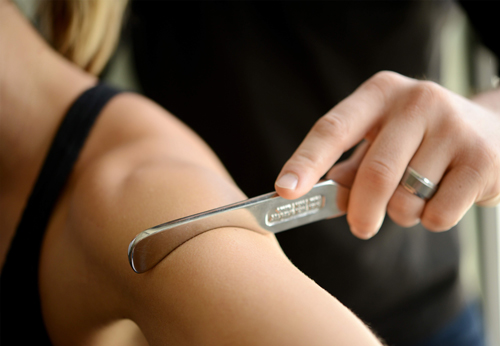Graston Technique
Graston Technique® (GT) is a unique, evidence-based form of instrument-assisted soft tissue mobilization that enables clinicians to effectively and efficiently address soft tissue lesions, fascial restrictions and scar tissue resulting in improved patient outcomes.
GT uses specially designed stainless-steel instruments with unique treatment edges and angles to deliver an effective means of manual therapy. The use of GT instruments, when combined with appropriate therapeutic exercise, leads to the restoration of pain-free movement and function. The instruments also are used diagnostically to assess the kinetic chain, in an efficient manner using the principles of regional interdependence
The most common conditions treated with Graston Technique® therapy are:
- Ankle Pain (Achilles Tendinosis/itis)
- Wrist Pain (Carpal Tunnel Syndrome)
- Neck Pain (Cervical Sprain/Strain)
- Fibromyalgia
- Tennis Elbow (Lateral Epicondylosis/itis)
- Back Pain (Lumbar Sprain/Strain)
- Golfer's Elbow (Medial Epicondylosis/itis)
- Knee Pain (Patellofemoral Disorders)
- Heel Pain (Plantar Fasciitis)
- Shoulder Pain (Rotator Cuff Tendinosis/itis)
- Scar Tissue
- Shin Splints
- Trigger Finger
- Women's Health (Post-Mastectomy and Cesarean Scarring)
When viewed under a microscope, normal tissue can be organized in a couple of different fashions: dense, regular elongated fibers running in the same direction, such as tendons and ligaments; or dense and loose, irregular with fibers running in multiple directions. In either instance, when tissue is damaged, it will often heal in a fibrotic, haphazard manner and may appear radio-dense under diagnostic ultrasound. The tissue may show thickening, irregular organization or less precise margins as compared to non-injured tissues, which results in a restricted range of motion and, very often, pain and functional limitations.
Scar tissue limits range of motion due to its negative impact on sensory motor firing rates and frequencies. Abnormal sensory inputs perpetuate a dysfunctional cycle of nervous system sensitization, pain and dysfunctional movement/motor output. GT offers a positive method of manual therapy that interrupts and breaks this cycle of pain and dysfunctional movement.
